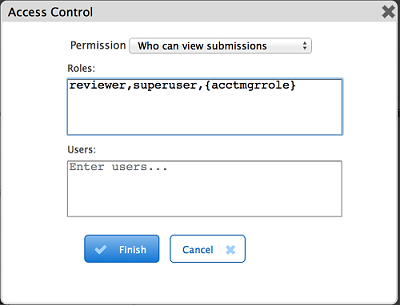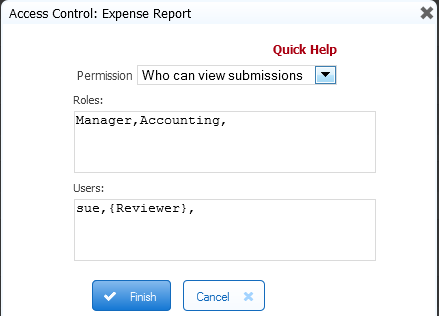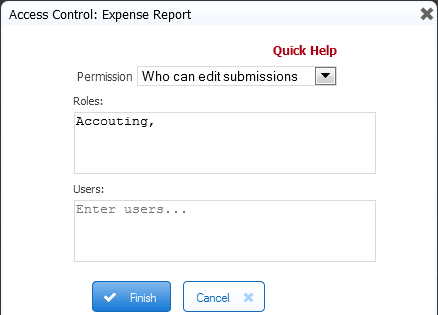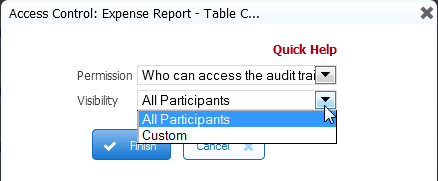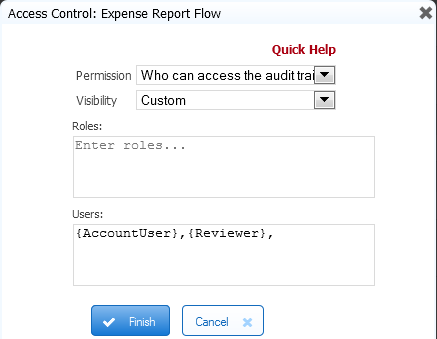This documentation is for frevvo v10.0. Not for you? Earlier documentation is available too.
Access Control List for Publisher Users
frevvo users with the frevvo.Publisher role perform a special function explained here. Publisher users have the ability to change ACLs for the forms/workflows that they are moving from the development environment to production. They cannot, however, edit those forms/workflows to use the Form/Workflow Properties Wizard to do so.
Publisher users access the Access Control List by clicking a form or workflow's Action Menu and selecting Security after they have logged into a designer user's account.
Designer users can also display the Access Control List by selecting Security on the Forms and Workflows Home Page but we encourage designers to use the Form/Workflow Properties Wizard to assign permissions.
On This Page:
The Access Control wizard makes the following permissions available for forms/workflows:
- Who can use the form/workflow?
- Who can edit the form/workflow?
- Who can view form/workflow submissions?
- Who can edit form/workflow submissions?
- Who can access the audit trail - available only for workflows
- Who can administer the workflow - available only for workflows
ACL Permissions for Forms
ACL Permissions for Workflows
ACL settings,set by the designer, are retained when you download/upload a form/workflow/app to another designer user in the same or different tenant and when you copy a form/workflow.
Dynamic ACLs
Templates provide the ability to dynamically determine and restrict access to submissions/ task audit trails when assigning Access Control permissions. Templates are like variables in your form that can be filled in by the user, populated by a business rule or from a back end system. Any item on the Access Control screens contained in curly braces is a form template and will be replaced with the value of the associated control. For example, the list below contains two fixed roles(reviewer and superuser) and one dynamic template based role - {acctmgrrole} :
In the example discussed below, templates are used to navigate the workflow to the correct employee in the Accounting department and to define user lists to dynamically control access.
Who can start the form/workflow
Setting this permission determines who is allowed to create form/workflow submissions. The choices for Form/Workflow visibility are:
- Anyone(login not required) - anyone can use it even if they are not logged in.
- Authenticated Users(login required) - the form is usable to anyone who has an account (username/password) and is logged in to your tenant.
- Designers/Owner Only - the designer user who created the form/workflow (owner) can edit, test or use the form. They must be logged into frevvo.
- Custom - The owning designer always has access to the form/workflow. Additionally, the designer may configure selected users and/or roles (i.e. users with these roles) to have runtime access to the form/workflow.
Who can edit the form/workflow
- Edit permissions should not be given to forms or workflows currently in production use. Please see the Admin Best Practices Guide
- Users with this permission have the ability to run the Refresh Searchable Fields process for the forms/workflows they are editing. This process updates existing submissions if changes are made to Searchable Fields.
Form and workflow owners (designer users that created the form/workflow) can give other users (designers/non-designers) the capability to edit form/workflows. This is particularly helpful if a designer user takes a leave of absence or leaves the company. The "backup designer" has the ability to make changes to the form/workflow without having to download the form/workflow(s) from the owner's account to the backup designer's account. The "backup designer" also can view related submissions by clicking on the Submission or Legacy Submission icons. The ability to edit submissions is granted by a different permission.
Users with or without the role of frevvo.Designer can be assigned the permission to edit forms/workflows.
Users given this permission access the shared form/workflow from the Shared Items tab even if they have the frevvo.designer role assigned to them. They can only edit the form/workflow that was shared with them. They will not have the ability to create new forms/workflows from the Shared Items tab. The ability to make changes to a form/workflow is not available from Shared Items on the Important Items menu in a frevvo space.
To assign users the ability to edit forms/workflows, follow these steps:
- Open the Access Control wizard by clicking the Lock icon on the Forms and Workflows Home Page or on the Form/Workflow designer toolbars.
- Select Who can edit the form/workflow from the Permission field dropdown.
- Enter the roles that you want to grant editing capability to, separated by commas, in the Roles section.
- Enter the users that you want to grant editing capability to, separated by commas, in the Users.
- Click Finish or select the next option in the dropdown to continue with the Access Control List.
Users that have been granted the editing permission, access forms and workflows that have been shared with them via the Shared Items tab on their Home Page. It will not work from the Shared Items selection in a Space or any other embedded scenario.
The Who can edit the form/workflow permission does not apply if you are running frevvo with Confluence. Confluence users share form/workflow editing by specifying the Forms Editor group on the Edit Tenant screen. Users who will be sharing the editing function must be assigned to the specified group.
A browser notification message displays if the user who has been granted permission to edit forms/workflows tries to modify their own ACL. frevvo will not allow the "backup designer" to remove themselves from the ACL list.
Who can view submissions
The designer can assign permission to view form/workflow submissions to specific roles/users. Any user with view access can view submissions in read-only mode. Submission deletion is not allowed. Templates can be used to dynamically determine at runtime which users and roles are allowed to view submissions.
To assign permission to view submissions, follow these steps:
- Open the Access Control wizard by clicking the Lock icon on the Forms and Workflows Home Page or on the Form/Workflow designer toolbars.
- Select Who can view submissions from the Permission field dropdown.
- Enter the roles you want to grant view access to, separated by commas, in the Roles section. You can enter control names from your form/workflow encased in curly braces to act as templates for dynamic access.
- Enter the users you want to grant view access to, separated by commas, in the Users section. You can enter control names from your form/workflow encased in curly braces to act as templates for dynamic access.
- Click Finish or select the next option in the dropdown to continue with the Access Control List.
Who can edit submissions
The designer can assign permission to edit form/workflow submissions to specific roles/users. Any user with edit access can view, edit and delete submissions in the SUBMITTED, ABORTED or ERROR states. Submissions in the PENDING, SAVED or WAITING states can only be deleted by the tenant admin, workflow admin or designer user that created the workflow. Refer to the Deleting Submissions for more information.
Templates can be used to dynamically determine at runtime which users and roles are allowed to edit submissions.
To assign permission to edit submissions, follow these steps:
- Open the Access Control wizard by clicking the Lock icon on the Forms and Workflows Home Page or on the Form/Workflow designer toolbars.
- Select Who can edit submissions from the Permission field dropdown.
- Enter the roles you want to grant edit access to, separated by commas, in the Roles section. You can enter control names from your form/workflow encased in curly braces to act as templates for dynamic access.
- Enter the users you want to grant edit access to, separated by commas, in the Users section. You can enter control names from your form/workflow encased in curly braces to act as templates for dynamic access.
- Click Finish or select the next option in the dropdown to continue with the Access Control List for workflows.
Who can access the audit trail - Workflows Only
The audit trail is accessed on a frevvo user's Task List by clicking the View Task History icon. Roles/Users granted this permission will see theView Task History icon on tasks in their task list.
To assign permission to view the audit trail, follow these steps:
- Open the Access Control wizard by clicking the Lock icon on the Forms and Workflows Home Page or on the Workflow designer toolbar.
- Select Who can access the audit trail from the Permission field dropdown.
- The Permission dropdown has two choices: All participants and Custom
- All participants indicates that any user that participated in the workflow can view the audit trail for the task (provided they have access to the task).
- Custom indicates that only users granted explicit access or with one of the specified roles can view the audit trail for the task (provided they have access to the task). Roles and users can be selected via an editable combo-box control.
- Enter the roles you want to grant audit trail access to, separated by commas, in the Roles section. You can enter control names from your workflow encased in curly braces to act as templates for dynamic access.
- Enter the users you want to grant audit trail access to, separated by commas, in the Users section. You can enter control names from your workflow encased in curly braces to act as templates for dynamic access.
- Click Finish or select the next option in the dropdown to continue with the Access Control List for workflows.
Who can administer the workflow - Workflows Only
This permissions let a user abort, reassign and reset tasks that are not assigned to them. These administrative tasks are no longer restricted to tenant admins.
The designer can delegate these tasks to additional users/roles by assigning them in the Who can administer the workflow section of the Access Control dropdown. Any user/roles listed here will be considered a Workflow Administrator. As such, the Modify Task icon on a task in the task list will be displayed. Tenant admins and designer users get the Modify Task icon by default.
To assign user/roles as Workflow Administrators, follow these steps:
- Open the Access Control wizard by clicking the Lock icon on the Forms and Workflows Home Page or on the Workflow Designer toolbar.
- Select Who can administer the workflow from the Permission field dropdown.
- Enter the roles you want to assign as workflow administrators, separated by commas, in the Roles section. You can enter control names from your workflow encased in curly braces to act as templates for dynamic access.
- Enter the users you want to assign as workflow administrators, separated by commas, in the Users section. You can enter control names from your workflow encased in curly braces to act as templates for dynamic access.
- Click Finish to save the completed Access Control List.
User jerry has been designated as a workflow administrator for the Expense Report but not for the Time Sheet workflow. When Jerry logs into frevvo, his task list will appear as shown:
The Modify Task dialog allows a 'workflow admin' to execute any one of abort/reassign/reset functions.
When searching for tasks, if a workflow is chosen, and the user is a workflow admin for it, then all tasks for that workflow display. If no workflow is selected, then all tasks, even those that the workflow admin has not participated in, plus tasks for which the user is a workflow admin will display.
